November 26, 2025 | 20:09 GMT +7
November 26, 2025 | 20:09 GMT +7
Hotline: 0913.378.918
November 26, 2025 | 20:09 GMT +7
Hotline: 0913.378.918
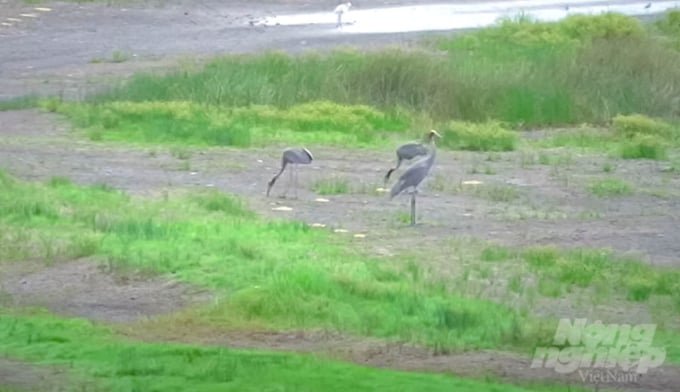
April 2021 is the most recent time Tram Chim National Park Conservation Center recorded a few red-crowned cranes coming down to the national park to feed.
Tram Chim National Park covers an area of 7,313 ha, not only a place to preserve biodiversity but also to preserve the culture and history of Dong Thap Muoi wetland. Tram Chim is recognized as the world's 2,000th wetland reserve (Ramsar site) and the fourth in Vietnam, with 230 species of birds, 130 species of fish, and 130 species of plants.
However, according to Doan Van Quick - Deputy Director of Tram Chim National Park Conservation Center, in recent years, climate change and environmental degradation in the Tram Chim National Park area have become more evident. April 2021 is the last time the red-crowned crane was recorded in Tram Chim National Park with 3 individuals.
Not only climate change, smog and industrial wastewater from factories adjacent to Tram Chim National Park directly affect the living environment of organisms, at risk of being seriously reduced.
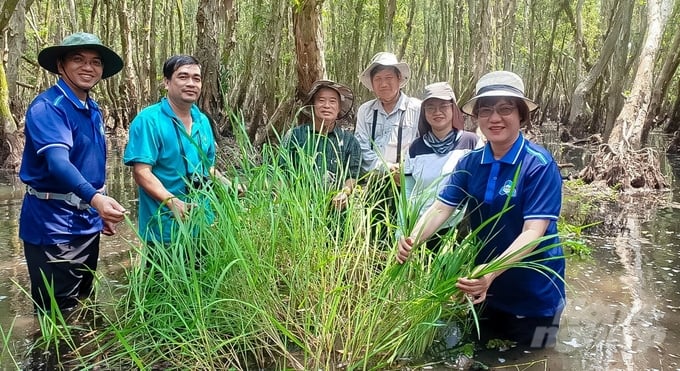
The food of the red-crowned crane and many other animals is also at risk of being unable to survive in Tram Chim National Park and must be conserved. Photo: Le Binh.
An enterprise is also applying to establish a mining industry cluster near Tram Chim National Park. Experts have warned that the activities of industrial clusters, such as noise, will strongly affect the physiology and behavior of birds and reduce their density. Some species will have to move elsewhere.
Assoc. Prof. Dr. Dang Vu Bich Hanh - Head of the Environmental Engineering Department (Faculty of Environment and Natural Resources, Ho Chi Minh City University of Technology), analyzed: "Nature conservation in the buffer zone area is critical, increasing the ability to protect biodiversity inside the nature reserve. Breaking the buffer zone principle means self-destruction".
Recently, the delegation of Dong Thap province came to Tram Chim National Park to investigate and find a way to overcome and discuss how to keep the red-crowned crane's legs. Le Quoc Phong - Secretary of the Dong Thap Provincial Party Committee, expects the province to try to raise and maintain a herd of red-crowned cranes with at least 100 individuals in the next ten years. The project has a total cost of about VND 76 billion. Accordingly, many synchronous measures will be taken, including solutions to improve the environment and change the farming practices and practices of people around Tram Chim National Park.
Dr. Dang Vu Bich Hanh is one of the scientists carrying out a research project to monitor the water environment for biodiversity conservation and adaptation to climate change at Tram Chim National Park.
According to experts, this research is to examine how the water source is changed within five and ten years to determine the rules by which solutions can be overcome.
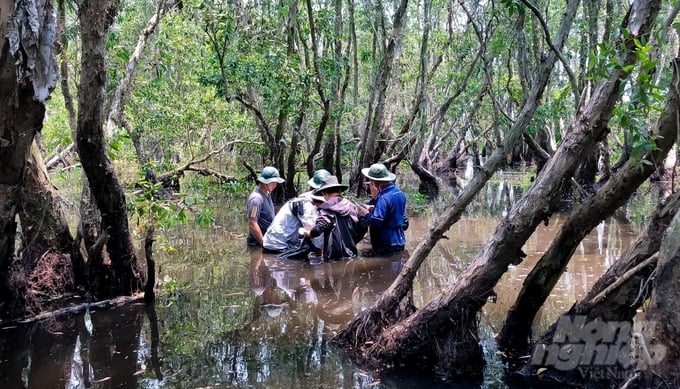
The research team of Ho Chi Minh City University of Technology is taking soil and water samples at Tram Chim National Park for analysis to make timely recommendations for managers. Photo: Le Binh.
"Water quality changes, plants, and aquatic life are changed. Since then, the food source from the water source is changed, and the birds, animals, and plants above are also varied, leading to the food chain being changed. A typical example is the needle tree - the red-headed crane's food is shrinking, which is why the cranes don't want to return anymore," said Dr. Hanh.
For more than a year now, the lecturers and students of Ho Chi Minh City University of Technology in the research project have been diligently taking samples for analysis, research, and manufacturing environmental monitoring equipment "made in Vietnam". It is expected that in November, Ho Chi Minh City University of Technology will test monitoring equipment at Tram Chim National Park to begin the conservation mission.
This monitoring device is manufactured by Ho Chi Minh City University of Science and Technology on the principle of automatic and semi-automatic, has high durability, is suitable for the environment of Vietnam, and is cheaper than imported equipment.
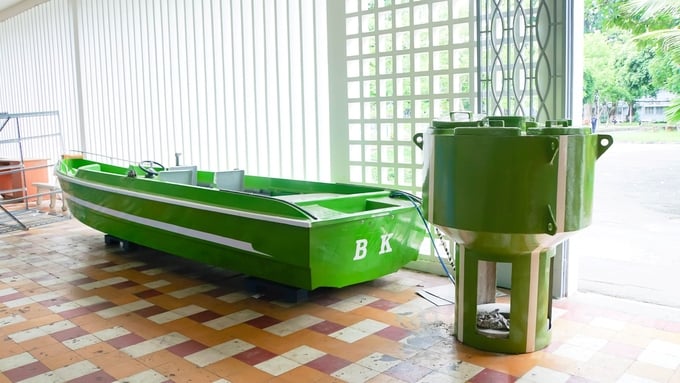
The monitoring product set includes a moving canoe and a floating-type monitoring device. Photo: Le Binh.
Once the data is available, the information will be automatically transferred to the processing center, where relevant organizations can publicly and conveniently exploit that data. Most importantly, this instant data will help managers promptly adjust and have appropriate warnings about the situation.
“Previously, data aggregation took a lot of time and had to wait for data analysis and reports, so sometimes management agencies missed the golden times to adjust all activities accordingly. This monitoring device will provide immediate data and intervention and limit the above situation. This will be an effective assistant for managers and researchers,” said Dr. Hanh.
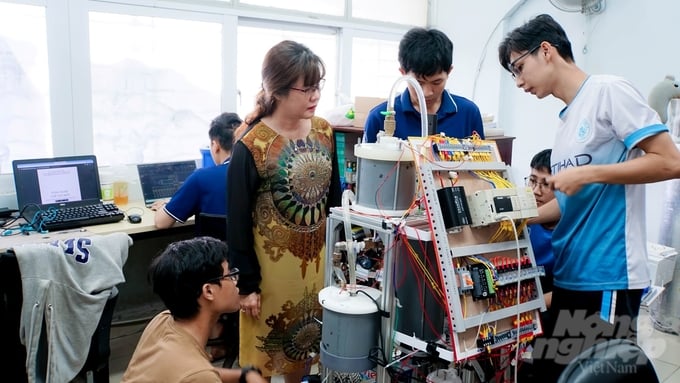
Assoc. Prof. Dr. Dang Vu Bich Hanh and his colleagues are completing the final technical steps before assembling the monitoring product. Photo: Le Binh.
Although it has not been put into operation, with the described functions, Dr. Tran Triet, Director of the Southeast Asia Crane Conservation Program, assessed it would be a new step in environmental monitoring in Vietnam. It may not be the most modern rated device, but it has the most technology integration, the cheapest cost, and is most suitable for the Vietnamese environment.
The monitoring product set is expected to be installed at Tram Chim National Park in November. This will help scientists answer questions about biodiversity protection, especially keeping the red-crowned cranes back to the world's 2,000th Ramsar site in Vietnam.
Translated by Ha Phuc

(VAN) The model of making a living under the forest canopy through the agroforestry system in Van Son commune, Bac Ninh province, is expected to generate an annual income of approximately VND 30 million/ha.

(VAN) Many enterprises in Can Tho are harnessing natural energy and reducing greenhouse gas emissions in their production processes, thereby contributing to the promotion of a sustainable green transition.
/2025/11/24/3536-2-112800_176.jpg)
(VAN) Dong Nai now has tens of thousands of hectares of forests certified for sustainable management, and this area will continue to be expanded in the coming period.

(VAN) Vinh Ha hamlet (Dai Xuyen commune, Hanoi) is shifting away from small-scale farming as households adopt bioscurity into their breeder chicken models.

(VAN) Heavy rains make aquatic species more vulnerable to disease. Proactive water management and high-tech systems help farmers prevent outbreaks and protect yields.

(VAN) Greenhouses are shifting production mindsets in Binh Lu commune, enabling farmers to ‘weather the sun and rain’ and secure stable vegetable harvests throughout the year.

(VAN) Green transition is crucial for the Mekong Delta amid climate change and stricter standards, offering a path toward sustainability.